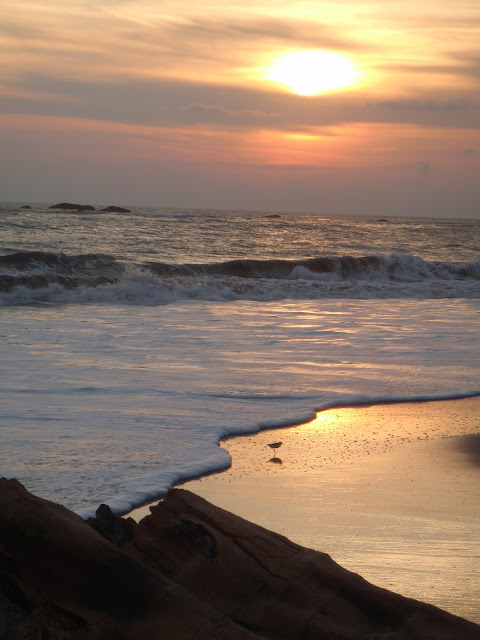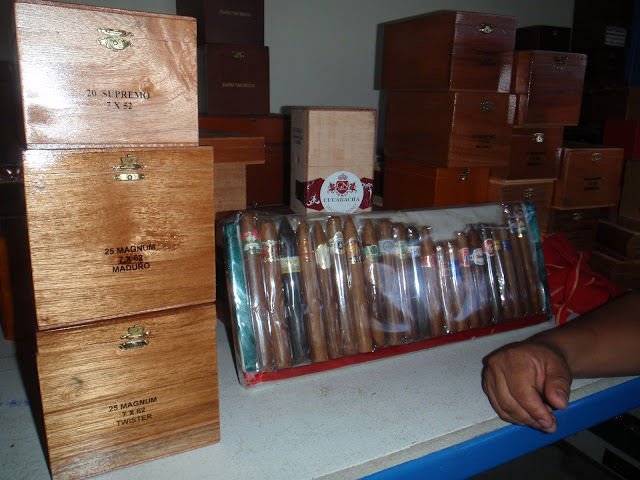
(Mike looking at

(driving through river #1)

(most of the drive was well packed surface through lots of trees, hills, turns)


(this stream was just a puddle, but I swear it looked deeper than that!)

(River #2 was deeper than that)
Stopping on a beach for a break outside of Tamarindo, an Argentine guy named Diego on a 1990 Yamaha Ténéré dropped by to say hi and complement the TA. Those beautiful old school dual sport machines were admired for a minute, but then the conversation about his travels and ours prevented us from getting a picture. Maybe next time we run into him...
Heading down the road, the TA started to cough a bit, especially when engine braking down hills. Eventually, she dropped to just one cylinder. Mike figured it was a faulty CDI but wanted to limp to a house, town, or place before digging into it. Instead, we coasted to a stop when both cylinders failed in front of a wonderful old couple´s house who lived right outside of Lagarto (S of Tamarindo, near Junquillal).

(view of the house we stopped in front of)
Lagarto is on our map, but maybe needn't be. It is a collection of about 60 people along the one dirt road, has one bar (that could strangely fit all 60 people into it at once), no food options, and the sight to see is one extremely large anchor that they pulled out of the ocean.
So no motorcycle help there. And Mike was out of options. Fuel was arriving, air filter was dry. After trying the spare CDI in both cylinders, neither showed a spark with a plug pulled. Thanks to that thieving in San Juan del Sur, we were without even a 12 V probe light, so electrical testing options were none.

(tent set up in the yard of the house we broke down in front of)
But the couple let us camp in their yard, and spent about 30 minutes that night calling everyone they could think of with a truck to get us back out to Santa Cruz, where they knew of a good mechanic. They found a guy who was really nice, came right when he said he would the next morning at 7am and got us there. It cost us US$50, which is not cheap, but not outrageous either.

(loading the bike onto the truck)

(our hosts at right, helping out yet again)
The mechanic in Santa Cruz found the fault - turns out it was that new aftermarket CDI ignition module that I swapped out for the still good original. It not only went bad, but managed to screw up the entire circuit it is connected to. The mechanic patched a hot wire to give power to the good CDI modules, and she fired right up!

(working on the bike at the shop in Santa Cruz)
So we made it to San Jose on the TA, which was much more fun than in a truck. Well, kind of....we got stopped by police for a US$30 shake down. They had a trap set up on the other side of this bridge:

Granted, I was passing along a solid yellow line, which is illegal, and could have cost us over US$800, so not too bad at $30. Fines in Costa Rica have recently been increased. Passing on solid yellow is over US$800. Speeding is over US$600. Not having documents is over US$200. And these aren´t gringo charges. Our host in San Jose had to pay a recent speeding ticket for US$600. And for you travelers, you aren´t supposed to be able to cancel your import permit to leave the country without paying the fine. ¡Cuidado!
We then joined the Panamerican which was 2 lanes under construction, full of slow moving trucks, and dumping cold rain through the mountains... it was a much longer day than we expected!
Our destination in San José was our couchsuring host´s home, conveniently located about 2km from the moto shop I wanted to get to, la Moto AG. We pulled straight to the shop where Jorg (spelling? it was German, and sounded like "Jorg") greeted us with a smile. While the TA was in the shop, I wanted to get new rear rubber on, the oil changed, check the front end alignment from our Guatemalan dog strike (bars are slightly bent), and fix that CDI circuit issue correctly. Jorg told us that our problems were small compared to what some travelers bring in. That was actually relieving. He ended up taking care of a new rear tire and brake cleaning, but then refered me to another mechanic for the electrical troubleshooting and other work. I would go back to la Moto AG and work with Jorg and their shop anytime. I would not, however, work with the BMW mechanic Luis again. (Details in upcoming posts, resolution to follow in El Rincòn, Panamà.)
After dropping the bike off that evening, we cabbed it over to the apartment complex, where Ivàn, our host, came running outside to meet us. We had spoken with him on the phone a couple times, but his first question in person was, "Do you eat meat?". He was cooking us up a spaghetti dinner which we absolutely devoured after not eating anything since breakfast. He is super nice, has backpacked all around Europe and traveled some around CA. His next plan is to buy a sailboat in the states, sail it back to San José, then across the Pacific to Asia.
















































